- NAPPIES
- BABY FOOD & FEEDING
- BABY CLOTHING
- BABY EQUIPMENT
- FAMILY ESSENTIALS
- THE PET SHOP
- BROWSE SPECIALS
|
Growth Charts
My first baby was big. In fact my obstetrician put me on a strict diet in the 2 nd trimester because he said I was going to give birth to King Kong. When I was giving birth to my daughter, she actually felt like King Kong too and she was the biggest baby in the nursery at hospital. Ever since birth, she was always teetering on the maximum growth curve. We saw endocrinologists, had bone scans, visited paediatricians, and they all came to the same conclusion that she was a big baby…some babies are born that way (my daughter is now 12 years old, 160cm tall and wears a size 39 shoe – her maternal grandfather was a 1 st grade rugby front forward). Different Types of Growth Charts When your baby is born, you will be given a growth chart to fill in with regular visits to a health care provider. There are 3 different types of growth chart curves (weight, height/length and head circumference), and these are separate for boys and girls (statistically boys should be bigger). These curves track age versus growth, comparing them to averages, and they are typically from 0 months – 2 years. There are also charts for children 2-18 years, which typically track weight, height and BMI (Body Mass Index). There are variations of these growth curves depending on country of origin (as people in some countries are generally smaller or bigger than others), so you will be given a growth chart based on the country of birth of your baby - although now I am not sure how useful this is considering high migration in the 21 st century. There are also charts specifically for children with special needs. Don’t get too hung up on these growth curves unless your child is outside the minimum or maximum. Why Growth Charts? With a new baby, it is useful to plot growth every 2 weeks on a growth chart, like the ones below. And once a child reaches 2 years of age, every 6 months. The reason why it is important to keep track of growth, is that it is a good indicator of health. For example, a mum in my mother’s group had a baby whose head circumference was on the low side, and she subsequently found out that her baby had craniofacial syndrome (her baby’s head had fused too soon). While I found out that I had very low quality breast milk when my baby was not putting on weight. How To Measure Weight It’s a good idea to buy some baby scales. I used to weigh my babies when they were asleep, so they didn’t wriggle and muck up the weight reading. I also pre-weighed their nappy and clothing beforehand – as a baby would get cold being naked while being weighed (and therefore wriggle even more). As a child gets older and a bit on the big side for baby scales, you can hold baby in your arms, step on a set of normal scales, then deduct your weight and total clothing weight to get the required reading. When a child is big enough to stand (and be still) then they can use normal scales on their own. Be sure to tell them that scales are not a type of small trampoline…as I have gone through my fair share of scales this way! 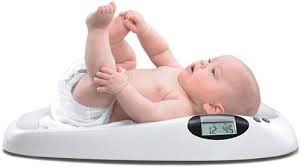
Head Circumference Measuring head circumference is pretty easy and all you need is a regular tape measure. Be sure not to measure from above the ear, but like the picture below. Also, remember that head circumference is not related to brain capacity, although if your partner marvels about how smart baby will be because they have a big head – humour them nonetheless. 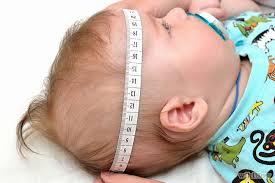
Length Measuring the length of a baby is a bit tricky, as they will instinctively want to curl up the legs, so it normally takes at least two people to do this at home. While hospital and clinics have fancy calipers or length boards to measure, you can do it at home with your measuring tape. Put the end of baby’s head against something flat (like a wall) and while one person holds the baby’s head against that, another person should straighten out the legs and measure from the wall to baby’s heel. 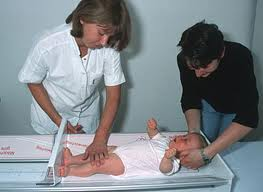
When a child gets older and can stand upright unaided, measuring height is easier, with a height chart taking pride of place in their bedroom. 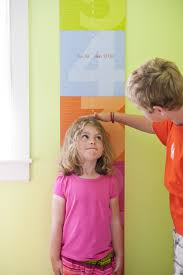
How to Read Charts After you have all your measurements, you can mark them on a chart, with baby age usually on the bottom and weight/height on the side. I found it easier to have a separate chart for each measurement, however a lot of charts allow multiple measurements on the one page (like the ones below). When reading the percentile charts, if a baby is on the 10th percentile (the bottom curve) for height and weight, it means that 90% of babies are taller and heavier than they are. A baby on the 80th percentile for height and weight is taller and heavier than 80% of other babies, and so on (my girl was always on the 98 th percentile for height and weight for a number of years). Finally, remember to take these filled-in charts with you when visiting health care providers. *Tip: Keep all health records for each child from pre to post natal in the one folder as these are often needed – even for subsequent births. 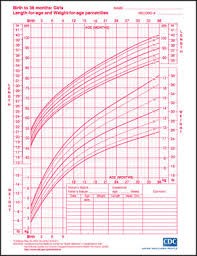 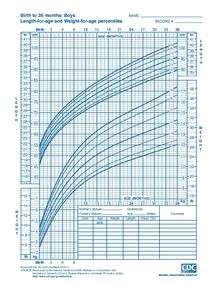
|